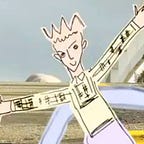After Childbirth, by Joanna Paul
By Joanna Osborne
I came across Joanna Margaret Paul’s AFTER CHILDBIRTH at a visit to her unpublished papers at the Alexander Turnbull library — a visit in support of part of a doctoral project on Joanna's religious sensibility in relation to her art practice.
While I was originally hoping to view some working drawings Joanna made for the design of a stained glass rose window for the Blessed Sacrament Chapel at Holy Family Church in Wanganui, I thought it would be nice to read through some of Joanna’s handwritten books of her poems. (Unfortunately the working drawings were administratively off limits due to storage space restructuring after last year’s earthquake).
When I chose an exercise book with, from memory, Poems for Mary hand-written on the front, I found this unpublished poem AFTER CHILDBIRTH with a thematic connection to Joanna’s use of the signifier O in a longer poem O, (published in Like Love Poems: Joanna Margaret Paul, selected poems edited by Bernadette Hall). The Govett-Brewster Art Gallery show All Lines Converge takes its title from an excerpt from the poem O.
Joanna articulated a dynamic relationship to the genre of still-life, specifically drawing connections between the changing circumstances of her life and variable approaches she made to the subject matter of her poems or visual images. These two poems push her usual subject matter to the margins (‘things in a room’, the furnishings of everyday life), and approach a broader phenomenological horizon.
In O, through the image of a rose, (another of Joanna’s recurring motifs), she situates herself at the centre of the poem — a position, she states, that sits outside the frame of the work, but where ‘all lines converge … hip / at the / centre / of the / rose / O.’
…
egg/ oval / & not a / printers O / we only know the circle / by its / absence / whiteness / perfection / ditto / ontology by / zero / the oval / earth / shaped by / forces / preponderant
…
Here emerges a Bachelardian phenomenology of roundness O as an image of being, and perhaps the ‘I-thou’ relational configuration (I think of the Jewish philosopher Martin Buber) that defines human relationships with the world, also intimated by Joanna in the act of composing an image: ‘…who…/reads (writes) / the poem / joins the / arch / of the / sea / but / thou O eye…” Drawing associations from the poem O, enriched my reading of AFTER CHILDBIRTH.
Cilla McQueen writes of Joanna’s use of white space as a ‘place for contemplation’, in her poem In/Out (for Joanna). In AFTER CHILDBIRTH whiteness is framed as a destination within a loose hierarchy, with O as a cipher for the presence and absence of whiteness beyond the page — a definition of transcendence as a relational configuration of desire.
Whiteness exercised a perpetual gravitational pull on Joanna. In a conversation with Lita Barrie in 1984, on the sensitivity required for negotiations with exhibition spaces, she quipped: “I could have perhaps put a white square there and drawn a line around it, [to say] well this is my space, this is my heart.”
Notes
AFTER CHILDBIRTH was first published in an essay by Joanna: ‘from Rooms and Episodes: 2 — Written at St Omer’. in brief #32, 2005, pp. 42 -55
See also re Joanna’s poetics, ‘Circling An Absent Centre: the Poetics of Joanna Margaret Paul’, by Cy Mathews.
Joanna Margaret Paul, Lita Barrie: Interview with Joanna Paul, Women’s Art Archive, 1984, Compact Cassette CA000053/001/0042, Museum of New Zealand Te Papa Tongarewa, Wellington New Zealand.
Joanna Osborne is a PhD candidate in Theology and Religion at the University of Otago with an interest in interdisciplinary conversations between religion and the arts. Some of her research on Joanna Margaret Paul should see the light of day in a contribution to the forthcoming book, Thresholds of Wonder: Poetry, Philosophy and Theology in Conversation edited by Jennifer Reek and Francesca Bugliani Knox, (Routledge).
Joanna has also written on Cilla McQueen, Ralph Hotere and Allie Eagle; and with Allie–
Joanna Osborne, “Encountering the Song of Spring in Ralph Hotere and Cilla McQueen’s Song of Solomon,” The Bible and Critical Theory, Vol II, No I (2015).
Joanna Osborne and Allie Eagle, “The Sudden Imperative and Not the Male Gaze: Reconciliatory Relocations in the Art Practice of Allie Eagle,” in Jason Goroncy (ed) Tikkan Olam. Eugene, Oregon: Pickwick, 2014.
Joanna Osborne, “The Sudden Imperative: Re-contextualisation and methodology in the recent work of Allie Eagle.” The Journal of New Zealand Art History Vol. 33, 2012–13. 73–86. The Hocken Collections Uare Taoka o Hakena University of Otago.
